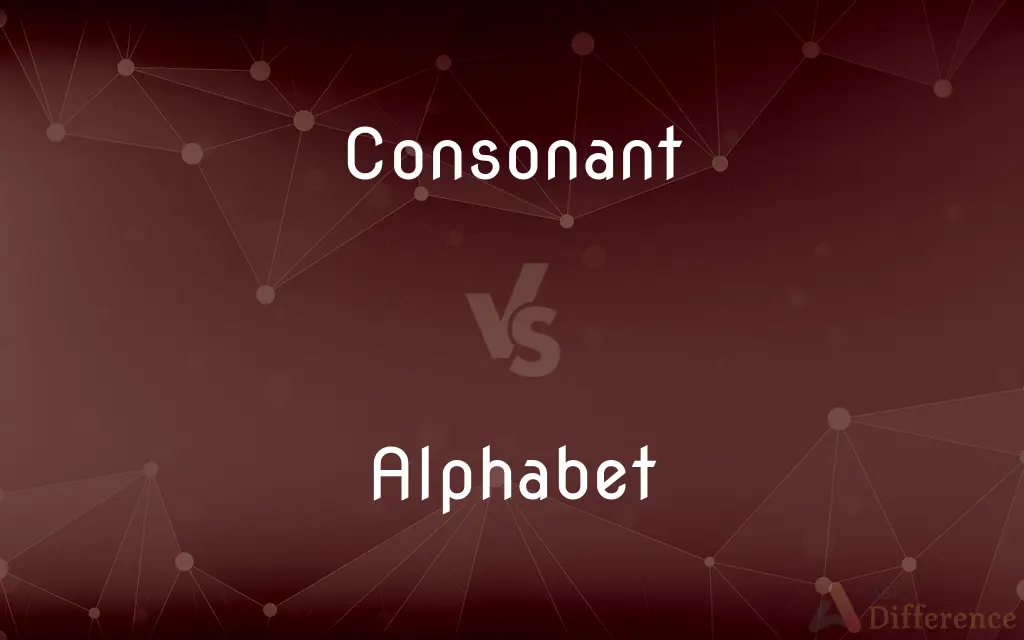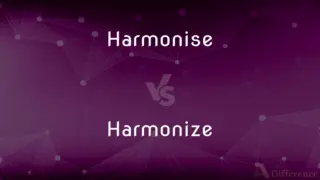Consonant vs. Alphabet — What's the Difference?
By Tayyaba Rehman & Maham Liaqat — Updated on April 26, 2024
Consonants are specific speech sounds produced by obstructing airflow, part of alphabets which include vowels and consonants representing entire speech systems.

Difference Between Consonant and Alphabet
Table of Contents
ADVERTISEMENT
Key Differences
A consonant is a type of sound in spoken language characterized by a closure or narrowing sufficient to cause audible turbulence, but it doesn’t form syllables by itself. Whereas an alphabet is a set of letters arranged in a fixed order used to represent the phonemes of a language and includes both consonants and vowels.
Consonants vary significantly between languages, with some languages having very few consonants, while others may have dozens. On the other hand, alphabets can vary in size depending on the number of phonemes in a language, ranging from very few characters in some alphabetic systems to many more in others.
In English, consonants include letters such as B, C, D, F, and so on, which represent specific sounds. Whereas the English alphabet as a whole consists of 26 letters, combining both 21 consonants and 5 vowels, showcasing the structure of the language.
Consonants can be voiced or voiceless, depending on the presence or absence of vocal cord vibration. Whereas the alphabet itself does not inherently possess phonetic qualities but is a system for graphically representing the sounds.
In teaching language, educators focus on helping students distinguish individual consonants and their sounds for proper pronunciation and spelling. On the other hand, teaching the alphabet often involves memorizing the order of the entire set of letters, facilitating the foundation of reading and writing skills.
ADVERTISEMENT
Comparison Chart
Definition
Sound made by closing or narrowing airways
Complete set of letters in a fixed order
Components
Only one type of sound (e.g., B, C, D)
Includes both consonants and vowels
Role in Language
Contribute to the phonetic composition
Represents entire phonetic system
Variability
Number and type vary by language
Varies in size, not in compositional nature
Educational Focus
Pronunciation and phonetic understanding
Order and recognition for reading skills
Compare with Definitions
Consonant
A letter of an alphabet representing a consonant sound.
S and F are consonants.
Alphabet
Used in the writing system of a language to form words.
The Greek alphabet is used to write Greek.
Consonant
Can be classified into groups like plosives, fricatives.
G is a plosive; Z is a fricative.
Alphabet
Fundamental for literacy.
Learning the alphabet is the first step in learning to read and write.
Consonant
Sound made by partial or complete closure of the vocal tract.
The letter T is a consonant.
Alphabet
Each letter has a fixed order.
The alphabet starts with A and ends with Z.
Consonant
Voiced or voiceless speech sound.
B is voiced, while P is voiceless.
Alphabet
Includes both consonants and vowels.
The alphabet includes A, E, I, O, U, and others.
Consonant
Essential for forming syllables in conjunction with vowels.
In cat, C and T are consonants.
Alphabet
A standard set of letters that represent phonemes of a spoken language.
The English alphabet has 26 letters.
Consonant
In articulatory phonetics, a consonant is a speech sound that is articulated with complete or partial closure of the vocal tract. Examples are [p], pronounced with the lips; [t], pronounced with the front of the tongue; [k], pronounced with the back of the tongue; [h], pronounced in the throat; [f] and [s], pronounced by forcing air through a narrow channel (fricatives); and [m] and [n], which have air flowing through the nose (nasals).
Alphabet
An alphabet is a standardized set of basic written symbols or graphemes (called letters) that represent the phonemes of certain spoken languages. Not all writing systems represent language in this way; in a syllabary, each character represents a syllable, for instance, and logographic systems use characters to represent words, morphemes, or other semantic units.The first fully phonemic script, the Proto-Canaanite script, later known as the Phoenician alphabet, is considered to be the first alphabet, and is the ancestor of most modern alphabets, including Arabic, Cyrillic, Greek, Hebrew, Latin, and possibly Brahmic.
Consonant
Being in agreement or accord
Remarks consonant with our own beliefs.
Alphabet
The letters of a language, arranged in the order fixed by custom.
Consonant
Corresponding or alike in sound, as words or syllables.
Alphabet
A system of characters or symbols representing sounds or things.
Consonant
Harmonious in sound or tone.
Alphabet
A set of basic parts or elements
"genetic markers ... that contain repeated sequences of the DNA alphabet"(Sandra Blakeslee).
Consonant
A speech sound produced by a partial or complete obstruction of the air stream by any of various constrictions of the speech organs, such as (p), (f), (r), (w), and (h).
Alphabet
The set of letters used when writing in a language.
The Greek alphabet has only twenty-four letters.
In the first year of school, pupils are taught to recite the alphabet.
Consonant
A letter or character representing such a speech sound.
Alphabet
A writing system in which letters represent phonemes. Contrast e.g. logography, a writing system in which each character represents a word, and syllabary, in which each character represents a syllable.
Consonant
(phonetics) A sound that results from the passage of air through restrictions of the oral cavity; any sound that is not the dominant sound of a syllable, the dominant sound generally being a vowel.
Alphabet
A writing system in which there are letters for the consonant and vowel phonemes. Contrast e.g. abjad.
Consonant
A letter representing the sound of a consonant.
Alphabet
(computer science) A typically finite set of distinguishable symbols.
Let be a regular language over the alphabet .
Consonant
Consistent, harmonious, compatible, or in agreement
Alphabet
An individual letter of an alphabet; an alphabetic character.
Consonant
Having the same sound.
Alphabet
The simplest rudiments; elements.
Consonant
(music) Harmonizing together; accordant.
Consonant tones; consonant chords
Alphabet
An agent of the FBI, the CIA, or another such government agency.
Consonant
Of or relating to consonants; made up of, or containing many, consonants.
Alphabet
(rare) To designate by the letters of the alphabet; to arrange alphabetically.
Consonant
Having agreement; congruous; consistent; according; - usually followed by with or to.
Each one pretends that his opinion . . . is consonant to the words there used.
That where much is given there shall be much required is a thing consonant with natural equity.
Alphabet
The letters of a language arranged in the customary order; the series of letters or signs which form the elements of written language.
Consonant
Having like sounds.
Consonant words and syllables.
Alphabet
The simplest rudiments; elements.
The very alphabet of our law.
Consonant
Harmonizing together; accordant; as, consonant tones, consonant chords.
Alphabet
To designate by the letters of the alphabet; to arrange alphabetically.
Consonant
Of or pertaining to consonants; made up of, or containing many, consonants.
No Russian whose dissonant consonant nameAlmost shatters to fragments the trumpet of fame.
Alphabet
A character set that includes letters and is used to write a language
Consonant
An articulate sound which in utterance is usually combined and sounded with an open sound called a vowel; a member of the spoken alphabet other than a vowel; also, a letter or character representing such a sound.
Alphabet
The elementary stages of any subject (usually plural);
He mastered only the rudiments of geometry
Consonant
A speech sound that is not a vowel
Consonant
A letter of the alphabet standing for a spoken consonant
Consonant
Involving or characterized by harmony
Consonant
In keeping;
Salaries agreeable with current trends
Plans conformable with your wishes
Expressed views concordant with his background
Common Curiosities
How many consonants are there in the English language?
There are 21 consonant sounds in the English language.
Does the alphabet only include consonants?
No, alphabets include both consonants and vowels.
What is a consonant?
A consonant is a speech sound produced by obstructing the airflow during pronunciation.
Can a letter be both a consonant and a vowel?
In English, letters are typically either consonants or vowels, but in other languages like Yiddish, letters like "Y" can function as both.
Why are consonants important in language?
Consonants are crucial for forming words and sentences, impacting pronunciation and meaning.
What is an alphabet?
An alphabet is a standardized set of letters used in the writing of a language.
Are all alphabets the same?
No, different languages use different alphabets, which may vary in number of letters and structure.
How do consonants vary between languages?
Different languages may have different sets of consonants, influenced by linguistic and phonetic variations.
What differentiates a consonant from a vowel?
Consonants are characterized by a closure or narrowing that impedes airflow, whereas vowels are voiced without such closures.
What is the smallest alphabet in terms of letters?
The Rotokas alphabet, used in Papua New Guinea, has only 12 letters.
Can alphabets influence the complexity of a language?
Yes, the structure and completeness of an alphabet can affect the ease of learning and using a language.
Are there any languages without consonants?
No, all spoken languages have consonants, as they are essential for forming distinct words and sounds.
What are common challenges in learning consonants?
Common challenges include differentiating similar sounds, learning correct pronunciation, and mastering the use of voiced and voiceless consonants.
How is an alphabet taught to beginners?
Alphabets are usually taught through memorization of the order of letters and their sounds.
How does knowing the alphabet help in learning a language?
Knowing the alphabet is fundamental to reading, writing, and proper pronunciation in a language.
Share Your Discovery

Previous Comparison
Paint vs. Varnish
Next Comparison
Harmonise vs. HarmonizeAuthor Spotlight
Written by
Tayyaba RehmanTayyaba Rehman is a distinguished writer, currently serving as a primary contributor to askdifference.com. As a researcher in semantics and etymology, Tayyaba's passion for the complexity of languages and their distinctions has found a perfect home on the platform. Tayyaba delves into the intricacies of language, distinguishing between commonly confused words and phrases, thereby providing clarity for readers worldwide.
Co-written by
Maham Liaqat















































